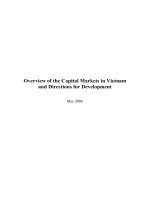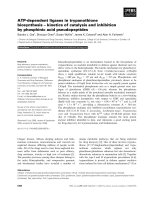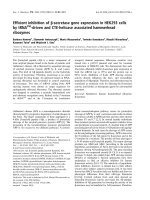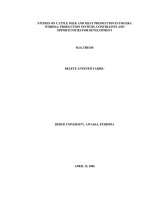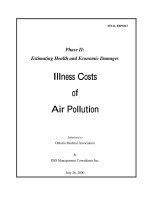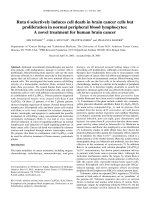Natural Resource Accounting in Goa Phase II: Integrated Research and Action for Development, New Delhi doc
Bạn đang xem bản rút gọn của tài liệu. Xem và tải ngay bản đầy đủ của tài liệu tại đây (1.39 MB, 147 trang )
PR-IRADe-08-2007
i
Natural Resource Accounting in Goa Phase II
Project Report
March 2008
Integrated Research and Action for Development,
New Delhi
PR-IRADe-08-2007
ii
Natural Resource Accounting in Goa Phase II
Project Report
March 2008
Project Team
Dr. Jyoti Parikh, Team Leader
Vinay Singh
Saudamini Sharma
Champak Buragohain
Sponsored By
Central Statistical Organization
Ministry of Statistics and Programme Implementation,
Government of India
Submitted By
Integrated Research and Action for Development,
New Delhi
PR-IRADe-08-2007
iii
Preface
This report contains the “Natural Resource Accounting of Goa State” and the valuation of
environment and forest ecosystem of Goa state.
In this report basic concepts on environmental accounting and different approaches of valuation
are described.
More specifically report covers the valuation in the specific sectors viz., air, water, municipal
solid waste, and forestry. Chapter 1 describes the introduction of Goa state and provides the key
indicators, Gross State Domestic Product, economic development of the state, land use and
human development indicators.
Chapter 2 carries out a study of municipal solid waste management and provides the approach
for sector and method to calculate the loss incurred due to solid waste. This chapter deals with
the solid waste generated by hotels, households and market places and economic and
environmental loss due to uncollected solid waste.
Chapter 3 describes the air and water pollution due to industries, households and transport. Air
pollution abatement costs are considered and methodology has been developed. Water pollution
status of various rivers are described and pollution for industries.
Chapter 4 describes forestry sector of Goa state. Forests cover more than 50 percent of land area.
As the forests are not valued properly, here calculations are made for economic valuation of
forest and indirect benefits from the forests, which are generally unaccounted.
Chapter 5 describes the Conceptual Framework for the green accounting and calculation of
overall Green SNP (System of National Products) for Goa as a whole. This chapter describes
pitfalls, problems, and some solutions for methodologies for economic valuation of environment.
The unique elements are: the treatment of Municipal Solid waste analysis done for the first
time in the context of natural resource accounting of a state, the treatment of hotel
industries- a service sector and tourism, corrected state domestic product after
environmental adjustments etc.
We hope that this study will show the feasibility as well as the need for carrying out the
environmental accounting and valuation. Kindly give us your feedback.
Jyoti Parikh
Executive Director, IRADe
PR-IRADe-08-2007
iv
Acknowledgements
We express our sincere thanks to Central Statistical Organisation for the cooperation in the study
of “Natural Resource Accounting of Goa”.
We acknowledge the support received from officials of the Central Statistical Organisation and
the following departments of the Government of Goa: Directorate of Planning, Statistics and
Evaluation, State Forest Department,Goa; Pollution Control Board and Department of Tourism.
We are thankful to Prof. Amitabh Kundu, Prof. D N Rao, Mr. J.Dash, Mr. Mohan Singh and Mr.
R C Aggarwal for their valuable suggestions and support.
In particular, we would like to acknowledge the valuable guidance provided by Dr Madhu
Verma, Professor IIFM Bhopal.
We are thankful to past project team members (Saudamini Sharma, Pallavi Maitra, Kapil,
D.Vidya, Manoj and IRADe staffs) for their sincere efforts.
Special thanks to Dr. Kirit Parikh for his valuable guidance and support.
PROJECT TEAM
Dr. Jyoti Parikh, Executive Director, IRADe; Team Leader
Vinay Singh
Saudamini Sharma
Champak Buragohain
PR-IRADe-08-2007
v
List of
Abbreviations
APC : Air Pollution Control
BIS : Bureau of Indian Standards
BOD : Biological Oxygen Demand
COD : Chemical Oxygen Demand
CNFA : Culturable Non-Forest Area
CSO : Central Statistical Organization
CPCB : Central Pollution Control Board
CVM : Contingent valuation method
DS : Dissolved Solids
ETP : Effluent Treatment Plant
GSDP : Gross State Domestic Product
HPM : Hedonic Pricing Method
HPU : Heavy Polluting Units
HRACC : Hotel and Restaurant Approval and Classification Committee
IRADe : Integrated Research & Action for Development
MC : Municipal Councils
MOSPI : Ministry of Statistics and Programme Implementation, GoI.
MoEF : Ministry of Environment and Forests
MSW : Municipal Solid Waste
NSDP : Net State Domestic Product
NWFPs : Non Wood Forest Products
NO
2
: Nitrogen Dioxide
NTFPs : Non-timber Forest Products
RSPM : Respirable Suspended Particulate Matter
SNP : System of National Product
SPCB : State Pollution Control Board
SS : Suspended Solids
SO
2
: Sulpur Dioxide
SPM : Suspended Particulate Matter
TCM : Travel Cost Method
TEV : Total Economic Valuation
PR-IRADe-08-2007
vi
Units
mg / L : Milligram per Litre
ppm : Parts per million
µg / m
3
: Micro gram per cubic metre
PR-IRADe-08-2007
vii
CONTENTS
Preface
Acknowledgements
List of Abbreviations
1
Goa Profile
Page No.
1.1 Introduction
1.2 Goa Development
1.3 Land-use Pattern
1.4 Economic Growth
1.5 Goa’s Contribution
1.6 State Income
1.7 NRA for Goa
1
2
3
4
5
5
11
2 Municipal Solid Waste Management
2.1 Objectives & Approach
2.2 SWM Practices in Goa
2.3 Survey Analysis of Hotels in Goa
2.4 Tourism Sector in Goa
2.5 Analysis of Hotel Survey
2.6 Municipalities in Goa
2.7 Methodology
2.8 Survey for SWM in Goa
2.9 Survey Design
2.10 Market Place Survey
2.11 Analysis of Municipal Survey
2.13 Total Cost of Collection of Solid Waste
2.14 Summary
13
14
14
15
18
21
22
23
23
28
29
31
34
3 Air and Water Pollution
3.1 Introduction
3.2 Types of Industries
3.3 Important Industries
3.4 Air Pollution in Goa
3.5 Outline if Survey
3.6 Survey Design
3.7 Methodology
3.8 Application of Methodology Results
3.9 Transport Sector
3.10 Energy & Emission Accounts
3.11 Water Pollution in Goa
3.12 Water Pollution Abatement Cost
3.13 Abatement Cost Function
3.14 Summary
35
35
36
38
39
39
41
41
46
48
50
54
55
56
PR-IRADe-08-2007
viii
4 Forest Resource Accounting of Goa
4.1 Introduction
4.2 Goa Forest Profile
4.3 Forest Values
4.4 Valuation Technique
4.5 Methodology for Valuation of Forest Resources
4.6 Accounting of Forest Resources
4.7 Physical Accounts
4.8 Monetary Accounts
4.9 Valuing Net Timber Accumulation
4.10 Valuing Direct Consumptive Benefits
4.11 Valuing Direct Non- Consumptive & Indirect Benefits
4.12 Estimation of Total Economic Value of Forest
4.13 Composition of TEV with SDP & Expenditure
4.14 Economic Value of Forest
4.15 Summary
57
58
68
68
71
72
73
80
82
83
84
85
87
88
89
5 Conceptual Framework & Green SNP for Goa
5.1 Conceptual Framework
5.2 Approaches to Valuation
5.3 Green SNP for Goa
5.4 Limitations of the study
90
92
97
98
ANNEXURES
ANNEX 1 Review of Pilot Project on NRA (Phase I)
ANNEX 2 Municipal SWM
ANNEX 3 Municipal Workers Details
ANNEX 4 Air & Water Pollution
ANNEX 5 Forestry Details of Goa
100
113
116
119
129
References
138
PR-IRADe-08-2007
1
1.1 Introduction
Goa is the smallest state in terms of area, located on the west coast of India and fourth smallest
state in terms of population. It is situated on the slopes of the Western Ghats. It is bounded on the
North by Sindhudurg district of Maharashtra, on the East by Belgaum, on the South by Karwar
Districts of Karnataka, and on the west by Arabian Sea. It has scenic natural beauty, attractive
beaches, and distinctive architecture, feasts and festivals of a unique culture.
The state has a geographical area of approximately 3,702 sq km. Estuary entrances and rocky
capes along the palm-fringed beaches are the typical geographical feature of Goa. Also, there are
wetlands at Carambolim. It has six rivers - Tiracol, Chapora, Mandovi, Zuari, Sal and Talpona.
They originate from the Sahayadri mountain ranges and flow westward into the Arabian Sea. It
has long coastline with a length of 105 kms.
Figure 1: Map of Goa
1
GOA PROFILE
PR-IRADe-08-2007
2
The state is distributed among its two districts and 11 talukas (local sub districts). Each of the
State's thirteen tehsils (revenue centers) has an industrial estate, an
industrial training institute and higher secondary level education facilities. The capital city of
Panjim is located on the banks of the Mandovi River. Vasco, Margao, Mapusa and Ponda are the
other major towns.
1.2 Goa’s Development
Goa has emerged as the most progressive State in the country and is ranked No.1 by the Eleventh
Finance Commission as the Best Placed State in the Country in terms of infrastructure facilities.
The National Population Commission has ranked Goa as the First State amongst all States/UTs
in terms of 12 indicators (composite index) on quality of life. CRISIL has declared Goa as the
second fastest growing State in the country. Various human development indicators of Goa are
given in Tables 1.1 and 1.2.
Table 1.1: Key Indicators of Goa
Sr.No.
Item (General)
Goa
India
1 Population* (in lakhs) 13.48
1028.61
2 Density of population (persons per sq.km). 363 324
3 Sex ratio* (females per 1000 males) 960 933
4 Urban population to total population* (%) 49.76 38.4
5 Decadal Growth Rate (1999-2001) 14.89 21.34
6 Geographical area (sq.km) 3702 3166285.0
7 Coastline (km.) 101 7,000
8 Total Forest Area (sq.km) 1,224 (33.06%)
774,740
(23.57%)
Source: *Census, 2001. *2001-02
Economic development brings about improvement in health and social factors. An analysis of
Table 1.1 gives us some important facts about the status of Goa in comparison to India. Goa has
a sex ratio of 960, which is much better than the national average of 933. Goa is the smallest
state in India but the forest area 33.06% and that is much better than national forest area of
PR-IRADe-08-2007
3
23.57%. The run of coastline of Goa is 101 km. The decadal growth rate of Goa is 14.89 that is
in a balanced position than other states of India.
Table 1.2: Human Development Indicators for Goa
Sr. No. Human Development Indicators Goa India
1 Population served per Hospital (2004) 9054 61810
2 Hospital beds (per 1000 population) 3.79 .70**
3 Birth Rate 15.95 26.4
4 Death Rate 7.46 8.8
5 Infant Mortality Rate 12.40 70.5
6 Literacy Rate (male) 88.88 75.96
7 Literacy Rate (female) 75.51 54.28
8 Literacy Rate (total) 82.32 65.38
Source: Directorate of Planning, Statistics & Evaluation, Panaji–Goa. & Census 2001
Table 1.2 gives human development indicators for Goa.The Birth rate is among the lowest in the
country, which has been declining consistently. The death rate is also very low at 7.7 per
thousand as compared to National average of 8.7 (2002). The infant mortality rate i.e. number of
deaths per thousand children before they attend the age of six years was 12.48 against the
national average of 70. A good indicator for health access to citizens is the Hospital beds per
thousand populations. In Goa this figure was around 3.79 per 1000 population as compared to
0.70 for the All India average.
Thus, we can infer from the above table that Goa has a very good record in terms of health
indicators.
1.3 Land use Pattern in Goa
The figure below gives the picture of land use pattern in Goa. Net sown area is about 40%,
cultivable wasteland is about 12%, land not available for cultivation is about 10% and the
contribution of forest is about 35%.
PR-IRADe-08-2007
4
Fig 1.1: Land Use Change in Goa, 1991-97
LAND-USE CHANGE IN GOA
0
50000
100000
150000
200000
250000
300000
350000
400000
1
9
9
1
-
9
2
1
9
9
2
-
9
3
1
9
9
3
-
9
4
1
9
9
4
-
9
5
1
9
9
5
-
9
6
1
9
9
9
6
-
9
7
YEAR
AREA IN HECTARES
NET SOWN AREA
CULTIVABLE WASTE
LAND
TREES & GROVES
PASTURE & GRAZING
LAND
LAND NOT AVAILABLE
FOR CULTIVATION
FOREST
1.4 Economic Growth
Progress achieved by Goa based on per capita net state domestic product at current prices during
the last four financial years is very strong and fluctuating each year. It is evident from the table
1.3 that per capita NSDP at current prices which was Rs.51, 073 in 2001-02 rose steeply to Rs.
60, 787 in 2002-03 but drop down in 2003-04 to Rs.57, 369 but again improved by a margin in
2004-05. Per capita NSDP at current prices of Goa stand far ahead of the national average per
capita NSDP, which was Rs.20, 171 in 2001-02 whereas, it was Rs.51, 073 for Goa. Though
national average showed signs of improvements, Goa is still ahead by a large margin.
PR-IRADe-08-2007
5
Table 1.3: Per Capita Net State Domestic Product at Current Prices (Rupees)
Sl.
No.
State 2001-02 2002-03 2003-04 2004-05
1.
Goa 51073 60787 57369 58184
2. Punjab 25868 26395 28607
30701
3. Maharashtra 24044 26858 28848 32170
4. Haryana 24883 26818 29504
32712
5. Himachal Pradesh 21570 22902 25059 27486
6. Kerala 20287 22778 24492 27048
7. Gujarat 19713 22624 26672
28355
8. Tamil Nadu 20326 21740 23358 25965
9. Karnataka 18091 19578 21238 23945
10.
West Bengal 17499 18494 20548
22497
11.
Andhra Pradesh 17932 19087 21372 23153
12.
Arunachal Pradesh
15577 16916 19029 19724
13.
Meghalaya 15813 16803 18135
19572
14.
Rajasthan 13621 12841 15738 16212
15.
Madhya Pradesh 12209 11500 13722 14069
16.
Assam 11423 12247 12821 13833
17.
Orissa 9879 10164 12645 13601
18.
Bihar 5004 5606 5362 5772
19.
Chandigarh 47734 53886 60105
67370
20.
Delhi 44286 45679 49494 53976
21.
Pondicherry 37926 45431 50936
56034
22.
Sikkim 17644 20013 22062 24115
23.
Tripura 17383 18550 20357
NA
24.
Manipur 12683 12878 13732 14901
25.
Jammu & Kashmir
13444 14507 15318 16190
26.
Uttar Pradesh 9320 9983 10637 11477
27.
Jarkhand 10129 11139 11999 13013
28.
Chattisgarh
12032
12369 14983
15073
29.
Mizoram 19704 22207 NA NA
30.
Nagaland 18911 20748 NA
NA
31.
Uttaranchal 13466 14947 16982 19652
32.
Andaman &
Nicobar Islands 25999 28340 NA NA
Source: Central Organization based on Directorate of Economics & Statistics of respective State
Governments (as on 21-11-2005)
PR-IRADe-08-2007
6
1.5: Goa’s Contribution to the National Economy:
Though, Goa is the smallest state in India, it contributes significantly to the national exchequer.
Every year about 2 million tourists (both Domestic and Foreign) visit Goa. Domestic tourism
also gives rise to economic activity and income in the state. Almost 15% (about Rs.1500 crore)
of the foreign exchange earnings from tourism are generated in Goa annually. Over 60% of the
total iron-ore exported from the country is from Goa alone, which is worth nearly Rs.1000 crore
per annum. Royalty from minerals like iron-ore also add revenue to the central kitty.
Approximately, 0.66% of the combined collection of income tax, excise duty and customs are
generated in Goa. Per capita contribution of the State from iron ore export, tourism, customs
revenue, central excise and income tax is referred to Table 1.4.
Table 1.4: Small State - But - Contribution to the Nation is significant-Goa:
Amount Per capita
S. No.
Particulars
(Rupees in
crore)
(in Rupees)
1 Customs Revenue (2001-02) 301.48 2243
2 Central Excise (2001-02) 626.98 4665
3 Income Tax (2001-02) 232.60 1731
4
Iron Ore Export - Foreign Exchange Earnings (2001-
02)
939.94 6899
5 Foreign Exchange Earnings from Tourism (1999) 1500 11062
Source: Economic Survey of Goa, 2003-04
1.6 State Income
The Gross State Domestic Product (GSDP) of the State at constant prices (1993-94) has
registered an annual compound growth rate of 8.7% during the period 1993-94 to 2001-02.
Tertiary sector contributes the highest amount to GSDP at 54.6 percent, followed by secondary
sector at 33.4 percent and the primary sector contributes only 12 percent.
Table1.5: Sectoral composition of GSDP at current prices (per cent)
Sl.No
Sector 1970-71* 1980-81 1990-91 2000-01
1 Primary Sector 30.9 24.3 19.9 12.0
PR-IRADe-08-2007
7
2 Secondary Sector 26.5 29.9 28.6 33.4
3 Tertiary Sector 42.6 45.8 51.5 54.6
4 GSDP 100.00 100.00 100.00 100.00
Source: Economic Survey of Goa, 2003-04
Primary sector
The contribution of primary sector to the GSDP is continuously on the decline (see table 1.6).
The share of primary sector in the GSDP has declined from 30.9% in 1970-71 to 12.0% in 2000-
01. At the national level too it has declined from 31% to 24% during 1993-94 to 2001-02. The
value added from agriculture in GSDP has declined from 16.5% in 1960 to less than 7% in 2000-
01. Waning agriculture activity in the State is also evident from the declining trend of work
participation in this sector. The percentage of workers in this sector has declined from 60% in
1960 to 27.5% in 1991 and to 16.6% in 2001 population census. This may be attributable to
small land holdings and pressure on land due to heavy urbanization leading to less economic
viability in relative terms. However, the Employment Generation Strategy unveiled by the
Government of Goa during 2003-04, is expected to help in the revival of agriculture and increase
in its contribution to GSDP in the State.
The value added from Forestry & Logging in GSDP has been declining in real terms. This can be
directly attributed to the steps taken under Forest Conservation Act, 1980 of Government of
India & Goa, Daman & Diu (Preservation of Trees) Act, and 1984 of Government of Goa. Both
the acts have put a ban on cutting of trees in public and private forests. The value addition from
this sector is on account of dead, dying and fallen trees from government forests salvaged
departmentally, major forest products comprising industrial/fuel wood and minor forest products
like bamboo, cane etc.
Secondary Sector
During the last four decades the industrial sector (secondary sector of the economy) in Goa has
grown considerably and their share of value addition in SDP has increased from about 8% at the
time of liberation to over 33% now. At the time of liberation there were a very few industries
like cashew processing, fruit and fish canning, laundry soap making, etc. Now the State has over
6000 small-scale industrial units and 154 medium and large industries in the organized sector.
PR-IRADe-08-2007
8
Manufacture of chemicals and chemical products occupies a significant proportion in the
industrial pie of the state; its contribution goes to 54% followed by 14% from manufacture of
food products & beverages. Manufacture of rubber and plastic products stands third major
contributor with a share of 5%. On the whole the secondary sector has registered an annual
compound growth rate of 7.4% at constant prices (GSDP) during the period 1993-94 to 2000-01
(table 1.6).
Tertiary sector
Tertiary sector registered a CAGR of 9.5 % during the period 1994-2001 at constant prices
GSDP. Tourism contributes the major share in the tertiary sector. Tourism as such is not taken
into consideration in the System of National Accounting directly, but we can look into other
sectors like Hotels & Restaurants, Trade and transport, which are mainly related to tourism
sector. The section “Trade, Hotels & Restaurants” contributes around 16.1% of NSDP at
constant prices (see table 1.7) in 2001-02.It has increased its share from about 9.3 percent in
1993-94 to 13.9 percent in 2001-02 of GSDP at factor cost at constant prices.
Other activities, which are closely related to tourism in tertiary sector, include Financing,
Insurance, and Real Estate & Business Services, which contribute around 18.2 percent.
PR-IRADe-08-2007
9
Table 1.7: Gross State Domestic Product at Factor Cost by Industry of origin 1993-94 to
2001-02 at Constant Prices (Rs. in lakh)
SN
Sector 1993-94 1995-96 1997-98 2000-01 2001-02
1 Agri, Forestry & Fishing
14.8 9.0 9.5 8.2 8.3
1.1
Agriculture
10.5 7.1 7.8 6.4 6.6
1.2
Forestry & Logging
0.5 0.2 0.2 0.2 0.3
1.3
Fishing
3.9 1.7 1.5 1.6 1.5
2 Mining & Quarrying
6.3 5.2 3.8 3.4 3.0
Sub Total - Primary
21.1 14.2 13.2 11.6 11.3
3 Manufacturing
23.9 26.5 29.6 29.0 29.5
3.1
Registered
19.0 22.0 24.9 24.3 22.9
3.2
Unregistered
5.0 4.5 4.7 4.7 6.6
4 Electricity, Gas and Water
Supply
1.8 1.7 1.7 1.7 1.9
5 Construction
4.4 5.1 5.1 6.2 6.1
Sub Total - Secondary
30.2 33.3 36.4 37.0 37.6
6
Trade, Hotels and
Restaurants
9.3 16.4 13.1 14.7 13.9
7 Trans, Storage & Comm.
15.2 10.8 10.3 10.1 10.3
7.1
Railways
0.2 0.3 0.3 0.3 0.3
7.2
Transport by other means
14.4 9.8 9.2 8.8 9.0
7.3
Storage &Communication
0.5 0.8 0.8 1.0 1.1
8
Financing, Insurance, Real
Estate & Business Services
12.7
15.9 17.3 16.9 16.9
8.1
Banking & Insurance
5.8 10.5 11.6 11.0 10.7
8.2
Real Estate, Ownership, of
dwel & Business Services
6.8 5.4 5.7 5.9 6.2
9 Comun. Social & Per.Serv
11.6 9.4 9.7 9.8 10.0
9.1
Public Administration
4.4 4.4 4.3 4.1 4.1
9.2
Other services
7.1 5.0 5.4 5.7 5.9
Sub Total - Tertiary
48.7 52.5 50.4 51.4 51.1
PR-IRADe-08-2007
10
10
Total GSDP
239668 393188 401462 429741 456701
Source: Economic Survey of Goa 2003-04
Table 1.7: Net State Domestic Product at Factor Cost by Industry of origin from
1993-94 to 2001-02 at Constant Prices (Rs. in lakh)
Sl.
No.
Sector 1993-94 1995-96 1997-98 2000-01 2001-02
1
Agriculture, Forestry &
Fishing
15.9 10.0 10.7 8.8 8.9
1.1
Agriculture
11.3 8.1 9.0 7.3 7.5
1.2
Forestry & Logging
0.5 0.2 0.3 0.3 0.3
1.3
Fishing
4.1 1.7 1.4 1.2 1.2
2 Mining & Quarrying
5.6 4.5 3.3 3.0 2.6
Sub Total - Primary
21.5 14.5 14.0 11.8 11.5
3 Manufacturing
25.8 25.8 28.8 28.1 28.7
3.1
Registered
22.7 21.1 23.9 23.2 21.6
3.2
Unregistered
3.1 8.1 10.1 10.4 9.7
4 Electricity, Gas and
Water Supply
1.0 1.1 1.1 1.1 1.5
5 Construction
5.0 5.8 5.8 7.2 7.0
Sub Total - Secondary
31.9 32.7 35.7 36.3 37.1
6 Trade, Hotels & Restaurants
10.7 19.3 15.4 17.3 16.1
7
Transport, Storage &
Communication
10.4 6.6 6.0 5.8 6.3
8
Financing, Insurance, Real
Estate & Business Services
13.4 17.1 18.8 18.3 18.2
9
Community, Social &
Personal Services
12.2 9.8 10.2 10.4 10.7
Sub Total - Tertiary
46.7 527.8 50.3 51.8 51.4
10
Total Net State Domestic
Product (NSDP)
200186 328458 333373 356844 383798
11 Per Capita NSDP (In Rs.) 16558 25364 25371 26730 28304
Source: Economic Survey of Goa 2003-04.
PR-IRADe-08-2007
11
1.7 Natural Resource Accounting for Goa
Measures of national income and output provide estimates of the value of goods and services
produced in an economy. The use of system of national accounts or national accounting was first
developed during the 1940s. Some of the more common measures are Gross National Product
(GNP), Gross Domestic Product (GDP), Gross National Income (GNI), Net National Product
(NNP), and Net National Income (NNI).
The need to focus on the development of environmental and resource accounts in the national
accounting framework can be explained by a number of factors. First, the national accounting
framework is well-established, having a history of more than 50 years of implementation around
the world. Second, the national accounts are a very influential source of economic information.
Environmental information linked with the national accounts can, therefore, be quickly and
easily integrated into existing economic decision-making processes. Third and perhaps the most
important reason is the desire by statistical agencies to address the long-standing environmental
criticisms of the national accounts. Briefly, they include neglecting to measure the contribution
of the environment to national wealth; treating the receipts from the depletion of natural
resources as current income rather than capital depletion; measuring the benefits of the use of the
environment but not the costs; and including expenditures to protect the environment as part of
gross production. Many of these criticisms are controversial and not all are accepted as
legitimate by all parties of the debate. Many countries have attempted to address one or more of
them in their environmental and resources accounts.
Some experts argue that so-called defensive expenditures should not be included in GDP because
they do not contribute to well-being but are, in fact, a cost of maintaining social order. GDP is
not intended to measure well-being and therefore should not be adjusted to correct for a failure to
do so. GDP is intended to measure the aggregate value of output in the economy, even if this
output is considered “regrettable” in the eyes of some. Arbitrarily leaving some kinds of output
out of the calculation would distort the picture of economic development and make it impossible
to study the relationship between revenue and expenditure in the economy.
Natural capital is generally considered to be divided into three principal categories: natural
resource stocks, land and environmental systems (or ecosystems). All are considered essential to
the long-term sustainability of the economy. Natural resource stocks are the source of raw
materials used in the production of manufactured goods. Land is essential for the provision of
space in which economic activity can take place. Ecosystems are essential for the services that
PR-IRADe-08-2007
12
they provide directly and indirectly to the economy, including cleansing of polluted air and
water; provision of productive soil; provision of biodiversity; provision of a predictable and
relatively stable climate; protection from harmful effects of incident solar radiation; and
provision of reliable flows of renewable natural resources.
The natural resource stock measures that we present reflect those resources that can be profitably
exploited given today’s prices and technologies. As the reserves are depleting, we keep on
searching for new ones to replace them. But all resources are ultimately finite, so this process of
replacement becomes gradually more difficult over time. For some resources (like sand and
gravel) there might be no foreseeable real limit on supply. For others, like conventional crude oil
and natural gas, the depletion of major reserves is already predicted for the first half of this
century. This makes it worthwhile tracking their evolution in physical terms. Another reason
motivates the monetary measure of these resources. This is that the wealth they represent can
make a very substantial difference in the economic position of the government that owns them.
And because the prices of resource commodities fluctuate widely and are determined by market
forces outside of state’s control, this wealth can vary from one year to the next. All-in-all,
tracking the evolution of country’s natural resource stocks makes sense from an environmental
and an economic viewpoint.
PR-IRADe-08-2007
13
Municipal Solid Waste Management
2.1 Objectives and Approach
Solid waste management poses a major environmental challenge. Most of our cities are unable to
manage their waste and litter almost everywhere marks most of our urban landscape. This is not
a matter of visual pollution but also breeds diseases and causes ill health. Thus one needs to
value the cost of unmanaged solid waste.
The objective of this chapter is to develop a methodology for valuing unmanaged solid waste and
illustrates it with sample data collected and gathered for this purpose.
Fig.2.1 Flowchart for collected and uncollected solid waste.
2
Households
Markets
Municipal Solid
Waste
Transport
Uncollected
Waste
Disposa
l
Hotels
Collected
PR-IRADe-08-2007
14
2. 2 Solid Waste Management practices in Goa:
Municipal Councils (MC) is responsible for collection, transportation and disposal of solid
wastes generated within the municipal limits. Households and establishments including hospitals,
private nursing homes, restaurants, etc., deposit their wastes in communal waste storage bins, for
subsequent collection (manual) and transportation to a dumping site. A large number of waste
pickers make their livelihood by collecting a variety of recyclable wastes from bins and the
disposal site. Silt from storm water drains and construction wastes are collected separately by the
MC’s engineering division for disposal in low-lying areas.
2.3 Survey Analysis of Hotels in Goa
The present survey of hotels in Goa, is carried out to quantify tourism (within the hotel industry)
and its role in the Goa economy. The target population of the survey includes hotels (5 Star, 3
star, 4 star and budget hotels) and the survey design is based on stratified sampling procedure
through a set of 3 separate surveys. These hotels could serve as major arrival and exit points for
an overwhelming majority of the tourists visiting Goa. Further, the geographical coverage of the
survey includes various districts of North and South Goa, with an objective of enhancing the
statistical precision of the estimates. The districts covered under North Goa are Pernem, Mapusa,
Panaji, Valpoi, Bicholim and Ponda. Similarly for South Goa, the districts covered in the survey
include Marmugao, Margao, Quepem, Cancona and Sanguem. The identification and mapping of
localities selected for the survey were conducted as under:
The entire state of Goa was divided into North and South and covered the above-mentioned
districts within both. A total number of 11 districts were selected as the first stage. This
comprehensive survey of hotels, wherein the primary respondents are hotel managers or owners
in Goa provides several details of tourism behavior. The interviewers were provided training for
a period of 3 days prior to the survey. The training was deemed necessary in view of the types of
concepts entailed in understanding and explaining the tourism sector as a whole and it also
enabled the interviewers to better communicate the problems to the field supervisors and survey
managers, and to comprehend the feedback. In addition, the presence of senior researchers
contributed strongly to increasing the motivation and dedication of the investigators.
PR-IRADe-08-2007
15
Note that the Hotel and Restaurant Approval and Classification Committee (HRACC), set up by
the Department of Tourism, classify the functioning hotels under the star system into six
categories from one to 5-Star Deluxe. A new category of Heritage Hotels has also been
introduced since 1994. The Department also re-classifies these hotels after every four years to
ensure that these hotels maintain the requisite standards. The Committee set up for the purpose
has representatives from Department of Tourism, Government of India, State Governments and
hotel and travel industry associations.
Some data relating to the average duration of stay by domestic and foreign tourists, total no. of
hotels with no. of rooms and no. of beds and average physical characteristics of waste generation
by hotels of the study areas are collected from the publications of the Central Pollution Control
Board (CPCB), Goa Pollution Control Board and The Department of Tourism (Government of
Goa) in India.
The information about tourist inflow, employment inclusive of wage levels, entry tax, size,
revenue generated, budget allotted for the tourism site are collected. Information is elicited on
type of hotel, structural characteristics, and location comprising distances from major tourist
spots, no. of beds, waste generated, treatment plants (if any), pattern of energy use, total water
intake is also elicited. The survey results for hotels are given in the Annexure.
2.4 The Tourism Sector in Goa
Most of the tourism in Goa is concentrated in the coastal stretches of Bardez, Salcete, Tiswadi
and Marmagao. Over 90 percent of domestic tourists and over 99 percent of the international
tourists frequent these areas. Two types of tourists with distinct needs, which this state satisfies,
visit Goa. The first is the domestic tourists, who comprise 80 percent of all tourists. The second
is the international tourists who visit Goa purely for the natural environment and beaches. Within
the category of international tourists are there are two sub-categories: backpackers and charter
tourists. Although both visit Goa for the beaches, the backpackers are not found in areas of
charter tourists; they prefer to mingle and live with the local communities. Whereas, the charter
tourists tend to stay in the luxury starred hotels.
In previous decades, a clear off-season for all tourists could be identified, today this is not so for
domestic tourists, who come throughout the year albeit in larger numbers in the non-monsoon
PR-IRADe-08-2007
16
months. However, international tourists avoid the monsoon months, as for them the use of the
beach is the prime attraction to come to Goa.
In 2002, it is estimated that domestic tourists traveled to Goa as compared to 1725140 in 2003,
reflecting a percentage change of 30.17 per cent. The highest inflow in 2003 was in the months
of March and April with percentage change in domestic tourist arrivals was 126.68 and 119.88
per cent respectively as compared to 2002.
Table 2.1: Percentage Change in Domestic Tourist Arrivals in 2002 and 2003
Month % Change
January 65.72
February 47.70
March 126.68
April 119.88
May 28.15
June 10.85
July 17.33
August 59.44
September 21.27
October -4.01
November -7.67
December 2.74
Total 30.17
Source: Tourism Statistics Goa 2004.
PR-IRADe-08-2007
17
Figure 2.2: Domestic Tourist Arrivals in Goa in 2002 and 2003
0
50000
100000
150000
200000
250000
january
f
e
b
r
u
a
ry
m
arc
h
april
m
ay
june
july
a
u
g
u
s
t
s
e
p
t
ember
october
no
v
e
m
be
r
december
Domestic tourist arrivals in 2002 Domestic tourist arrivals in 2003
In India, a total of 274215 foreign tourist arrived in India in January 2003, whereas the
corresponding figure for Goa is 38236 (13% of India). In December, the foreign tourist arrivals
stood at 319271 and 67792 for India and Goa respectively (Figure 3.2).
Fig 2.3: Foreign Tourist Arrivals in India and Goa in 2003
Foreign Tourist Arrivals in India and Goa in 2003
0
100
200
300
400
J
a
n
uary
February
Ma
rch
A
p
ril
May
J
u
n
e
J
u
ly
A
u
g
u
s
t
Sept
e
mber
Oc
to
be
r
November
D
e
cemb
e
r
Month
Numbers ('000)
India Goa
Source: Department of Tourism, Government of Goa.
A similar analysis for domestic and foreign tourist arrivals within Goa for the last 5 years suggest
that in the year 2000, a total of 1268513 tourist arrived in Goa, of which 976804 and 291709
were domestic and foreign tourists respectively (Table 3.2). In 2005, the arrivals are 300830 and
